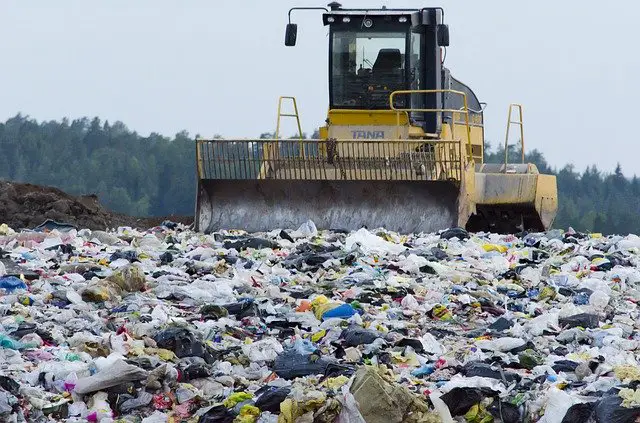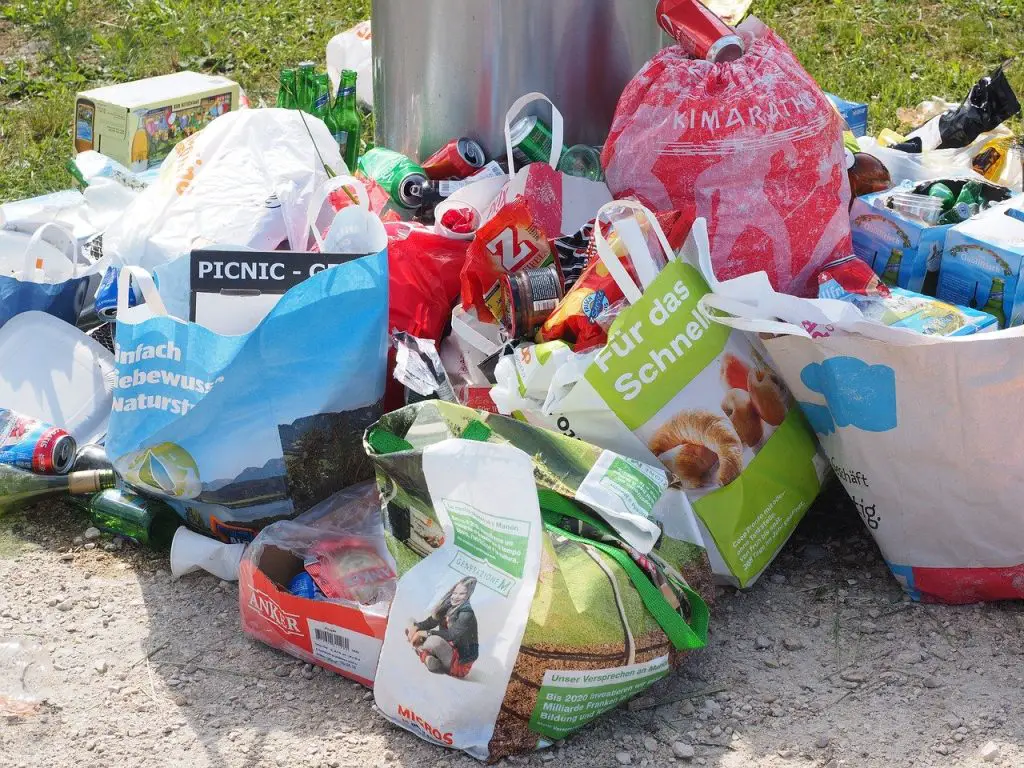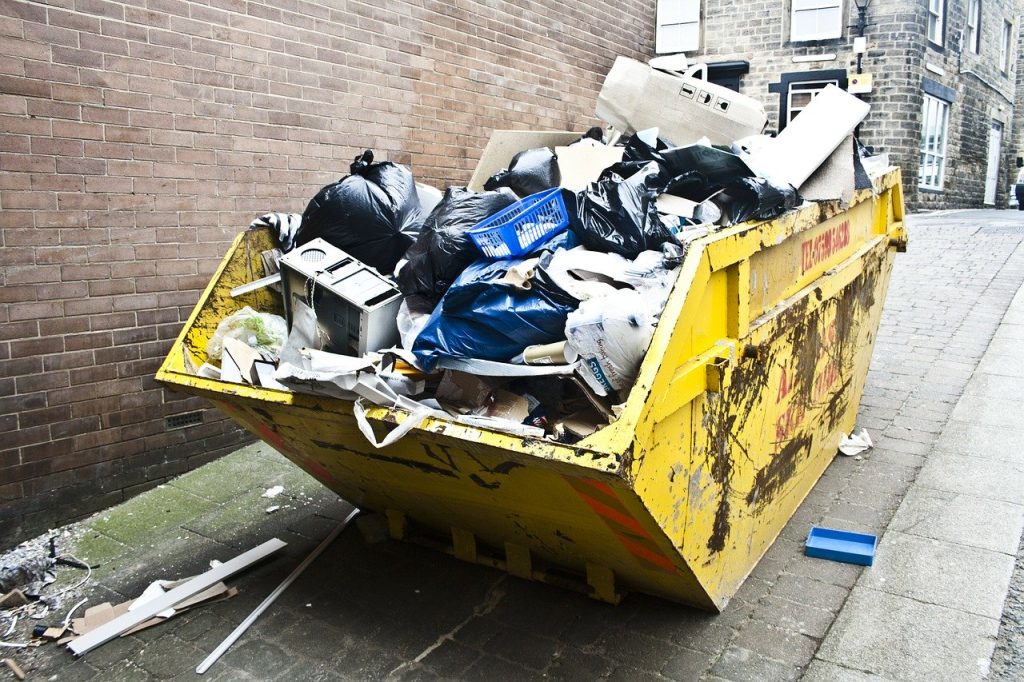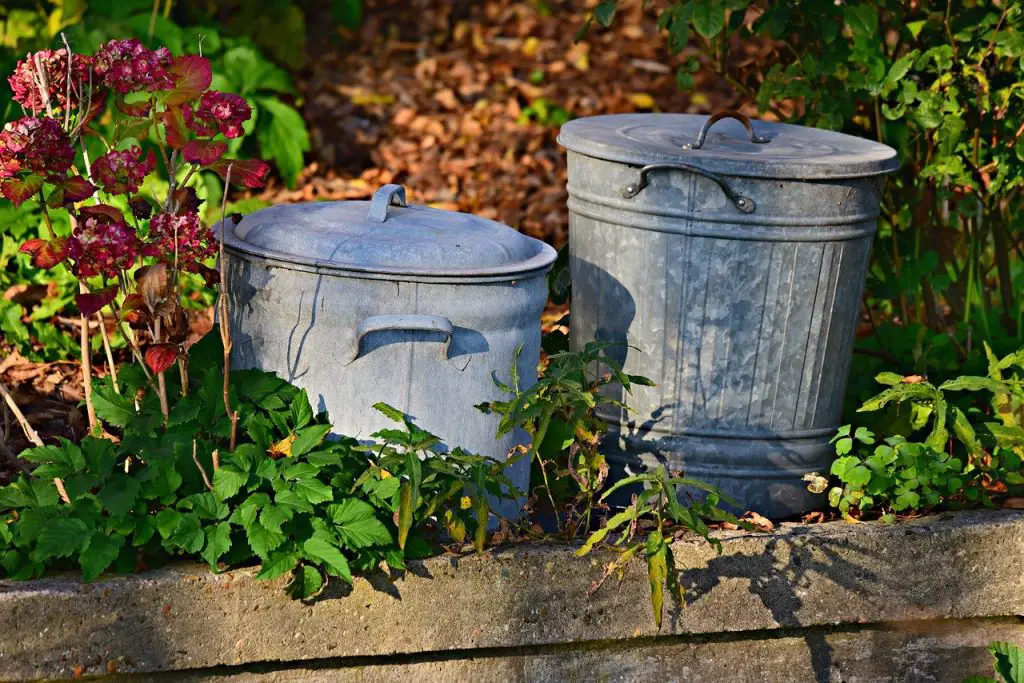“People say I’m extravagant because I want to be surrounded by beauty. But tell me, who wants to be surrounded by garbage?”
Imelda Marcos
What Is Waste Management or Waste Disposal?
Waste management, often also referred to as waste disposal, can be defined as actions necessary to manage waste from initial production to its final disposal.
This process includes the collection, treatment, transport, monitoring and also the regulation regarding waste.
Effective waste management processes are crucial in order to keep areas clean and to avoid adverse effects on the environmental system.
The quality of waste management differs across countries significantly.
Especially in poor developing countries, improper waste management still is a big problem.
This article answers all kinds of questions regarding waste management in order to improve public knowledge on this topic.
Audio Lesson
Contents
Waste Management Principles
- Resource efficiency
- Polluter pays
- Waste hierarchy
- Life-cycle
Resource efficiency
Due to a growing world population in conjunction with an increase in our individual consumption behavior, humanity currently consumes more than our planet can replenish.
This means that resources will become quite scarce over time or even entirely depleted.
Therefore, the concept of resource efficiency tries to mitigate this issue by stating that resources should be used in the most efficient way in order to save resources and sustain them for as long as possible.
Moreover, the extraction and manufacturing of products should be accomplished in a way that the adverse environmental degradation can be kept as low as possible.
Polluter pays
The polluter pays principle is straightforward since it states that pollution of all kinds of sorts and the related environmental costs should be borne by the polluting company or individual.
This makes quite a lot of sense since profit-maximizing companies usually only pay attention to the destruction of the environment if they have to pay the costs for their adverse impact.
However, in reality, the polluter pays principle is only anchored in a limited way.
This is especially true when it comes to negative externalities.
For example, air pollution through manufacturing processes contributes to global warming and the related adverse effects on many countries.
However, since companies are usually profit-maximizing, if there are no costs for pollution, these companies will continue to pollute the air since they do not have to deal with the adverse consequences.
Thus, in order to be able to mitigate this problem, we need a global emission framework in which every ton of emission of all sorts have to be priced in a way that companies have an incentive to lower their pollution levels significantly.
Waste hierarchy
Waste hierarchy is a concept which implies that products should be used, reused and recycled in a way that people can get the maximum benefit out of them.
This also implies that waste production should be minimized.
Thus, also the concept of reduce, reuse, recycle is closely related to the waste hierarchy pyramid.
Life-cycle
There are many different stages in the production processes of goods.
This usually includes design, manufacturing, distribution and use.
Moreover, after the use of a product, the concept of reuse and recycling comes into place.
In all of these stages, regulatory as well as private measures could be taken to make the production process more efficient in order to minimize waste production.

Types of Waste
- Liquid
- Solid
- Hazardous
- Organic
- Recyclable
Liquid
Liquid waste can include rainwater, detergents, dirty water and other types of waste in liquid form.
It is produced by all kinds of entities, including industries and private households.
Solid
Solid rubbish can include glass, ceramics, metal waste as well as paper waste.
It can come from industrial processes as well as from households.
Hazardous
Hazardous waste usually includes waste that is either toxic, flammable, reactive or corrosive.
It can pose serious threats to the environmental system.
This sort of waste has to be disposed of with sufficient care in order to ensure safety for our environment.
Organic
Organic waste includes garbage from fruits and vegetables as well as all garbage material that can be turned into manure with the help of microorganisms.
In order to make it available for reuse in an efficient manner, you should separate your organic waste from conventional waste.
Recyclable
Recyclable garbage includes all waste items that can be reused and recycled.
Recyclable waste usually includes solid waste items like paper, metals or glass.
Recyclable rubbish has to be separated from other household waste in order to be used for recycling purposes.
It is therefore important that you separate your waste properly.

Waste Management Regulations
There are many different regulations regarding waste management that significantly differ across countries worldwide.
For an overview concerning the various laws and regulations, take a look at this article.
Which Countries suffer from Improper Waste Management?
There are many countries worldwide that suffer from insufficient and ineffective waste management processes.
This problem is especially severe in developing countries where inefficient waste disposal processes lead to a significant level of pollution.
Moreover, in those countries, illegal disposing of waste poses an additional big environmental problem.
Making things worse, our Western world gets rid of its waste problem by simply shipping our trash to developing countries where it is reprocessed.
However, by doing so, some countries are simply overwhelmed by the waste they have to deal with and are likely not able to handle it in an environmentally-friendly manner.
Who pays for Waste Management?
Although companies often pay for the disposal of their waste, the price for this waste disposal is usually too low compared to the adverse environmental impacts.
Many countries do not factor in the social costs of pollution and the resulting negative externalities imposed on other countries.
This is often even done intentionally since governments want to strengthen their local economy and want to make it more competitive.
Thus, prices for waste disposal and the resulting pollution are often far too low to cover the negative global impact.
Why is the Management of Waste important?
Waste management is important since incorrect waste management can lead to all sorts of environmental problems.
For example, improper waste disposal can lead to a spread of epidemics or even pandemics.
Moreover, illegal disposal of waste often leads to significant levels of water and soil pollution which in turn also affects not only humans, but also the flora and fauna.
Therefore, sophisticated waste management is crucial in order to keep our planet in a healthy state.

Sources of Waste
- Industrial waste
- Household waste
- Food waste
Industrial waste
Industrial waste can be defined as garbage produced by industrial activities.
This includes gravel and dirt, masonry and concrete, oil, scrap metals, chemicals, solvents, scrap lumber and additional waste items produced by mills, factories and industries.
It may appear in gaseous, solid or liquid form.
Waste from industrial processes can be radioactive, corrosive, ignitable, toxic or reactive.
It can lead to the pollution of air, soil and water.
Household waste
Household waste can be defined as post-consumer waste which includes home care products, consumer products, personal care products, household chemicals, automotive care products and many more.
Due to the increase of the world population, the total amount of household waste has increased dramatically over the last decades.
Additionally, consumption behavior changed over time which resulted in the production of even more waste.
Examples of that include the increasing number of online purchases.
Items purchased online usually need more wrapping compared to products bought in a conventional store.
Moreover, people return their products quite frequently which causes even more waste since in many cases, not only the packaging has to be renewed, even the product itself will be disposed of due to regulatory or economic reasons.
Household waste can be quite harmful to our planet since many of our daily life products contain chemicals that can cause adverse ecological effects if not disposed of properly.
A fraction of our household waste even displays dangerous characteristics similar to regulated hazardous waste due to their potential for ignitability, corrosivity, reactivity, persistence or toxicity.
Examples include fuel, medical waste, motor oil, cleaning chemicals or batteries.
Food waste
Large amounts of food are produced on a daily basis.
However, a significant fraction is disposed into the garbage even before it reaches our food stores.
This is often due to minor issues that are often solely related to the appearance rather than to the quality of the food product.
For example, if a cucumber has too much curvature, it is classified as not suitable for our grocery stores and thus disposed into the trash can.
Since this is not only true for cucumbers but also for many other grocery items, this behavior leads to a significant waste of resources since the food would be suitable for consumption.
While many people worldwide suffer from starvation, a big fraction of our food is thrown away just because of its unaesthetic physical appearance.
Moreover, even if food items reach our grocery stores, a big fraction of our food ends up in the trash can since we do not consume it in time.
Additionally, many people are afraid to consume groceries if the best before date has been exceeded even if the food is in good shape and thus would be suitable for consumption.

Effects of Waste
- Air pollution
- Soil pollution
- Land pollution
- Smell
- Visual pollution
- Water pollution
- Nuclear accidents
- Global warming
- Effects on animals
- Effects on plants
- Effects on aquatic life
Air pollution
The production and the processing of waste can lead to significant amounts of air pollution.
Due to our increasing world population, the amount of waste which is produced each year also increases.
In order to get rid of this waste, it has to be dumped into landfills or burned.
In the combustion process, many harmful gases are emitted into the air, including CO2 which in turn leads to global warming.
Soil pollution
Large amounts of waste are dumped into landfills.
If these landfills are not set up properly, the soil can be contaminated with many harmful or even toxic substances.
This problem is especially severe in developing countries with low regulatory standards for landfills.
In those countries, many hazardous materials are dumped into landfills.
When they decompose, toxic elements are washed into the soil when rain sets in.
Land pollution
The production and disposal of waste also often leads to land pollution.
Among others, waste can come in the form of littering.
For example, people often throw their used cigarettes on the ground instead of using a trash bin, which in turn leads to land pollution.
Smell
Waste, especially organic waste, can lead to significant smell that can pollute the areas surrounding landfills.
If you live in a house near a landfill or a waste combustion plant, chances are that you are adversely affected by smell to a certain extent.
Visual pollution
Trash can also lead to visual pollution.
People usually prefer to spend their time in nice clean areas instead of areas that are covered with plastic or used cigarettes.
Therefore, if you live in areas with a high level of littering, you may suffer from visual pollution since your living comfort is lower compared to living in a clean neighborhood.
Water pollution
Incorrect waste management can also lead to significant water pollution.
Since in many developing countries, trash is disposed of illegally in rivers or lakes, the water gets contaminated with all kinds of harmful substances.
Moreover, if landfills are not set up properly, toxic substances may contaminate the soil and may eventually also be washed into the groundwater through rainfalls.
Nuclear accidents
If nuclear waste is not handled carefully, it can lead to all kinds of nuclear accidents.
For example, if a nuclear waste transporter is involved in an accident, this may lead to a leakage and thus may lead to the contamination of the surrounding ecosystem with nuclear substances.
Global warming
The production of waste also contributes to global warming. In order to get rid of the trash, large amounts of it have to be burnt.
In the combustion process, harmful greenhouse gases like carbon dioxide are released into the air which in turn lead to global warming.
Effects on animals
Animals can also be affected by the production and the disposal of waste.
If waste is illegally disposed into rivers, lakes or forests, the habitats of animals are contaminated with harmful substances.
Some animals will try to consume the trash, which may lead to diseases or other harmful effects.
Moreover, also animals suffer from the indirect effect of trash production on global warming since they are usually quite sensitive to changes in their natural living conditions.
When temperature increases, this could lead to a decrease in population or even to an extinction of certain animals if they are not able to adapt properly.
Effects on plants
Plants may also be affected by waste.
Through the combustion of waste, many harmful gases are released into the air.
Some of them are able to cause acid rain, which in turn changes the acidity level of the soil and therefore hurts a variety of plants.
Effects on aquatic life
Many water organisms are hurt by the production of trash and the implied adverse effects.
For example, through the combustion and the implied contribution to global warming, air temperature and also water temperature will increase.
An increase in water temperature also implies a decrease in oxygen levels.
This decrease in oxygen is a serious threat to many fishes since they rely on stable oxygen levels in order to survive.
Therefore, if oxygen levels decrease, many fishes are likely to decrease in population or even become extinct.
Moreover, if waste is dumped illegally into rivers or lakes, the water gets contaminated and water organisms will also be contaminated by toxic substances.
In addition, ocean dumping can cause serious adverse effects on water animals and plants.

Waste Disposal Problems
- Weak regulations
- Toxicity
- Lack of knowledge
- Private vs. public interest
- Short-term vs. long-term solutions
- High waste disposal costs
- Low fines for illegal dumping
- Excessive amounts of waste
Weak regulations
In many countries, especially in developing countries, there are often quite weak regulations in place that lead to improper and inefficient waste disposal processes.
Substances that should be regarded as hazardous are often dumped into landfills where they contaminate the surrounding soil.
Toxicity
A fraction of the overall waste is quite toxic and requires great caution when it comes to the disposal of those waste items.
Moreover, in some cases, some regions may lack appropriate waste disposal techniques regarding highly toxic waste which can lead to serious pollution of many sorts.
Lack of knowledge
There is a big gap in knowledge when it comes to waste disposal and proper waste management.
In many countries, especially in poor countries, knowledge regarding waste disposal is often quite basic and limited.
Thus, progresses in research will take quite long to impact the actual waste disposal behavior.
Private vs. public interest
In many cases, there is a conflict of interest between private and public interests regarding the topic of waste management.
Industries usually maximize their profits and produce the profit-maximizing amount of waste.
However, since they impose negative externalities on other people and even on other countries, the amount of waste produced by industries is usually far too high when regarded from a social perspective.
This is due to the fact that industries are insufficiently punished when it comes to topics like air pollution.
Air pollution has many adverse effects on the world population.
However, since industries in many countries do not have to pay for polluting the air, they are willing to emit large amounts of harmful gases and also produce excessive amounts of waste since they are not charged sufficiently for those negative externalities.
Short-term vs. long-term solutions
When it comes to managing waste, there is also the decision of short-term vs. long-term thinking.
For instance, dumping radioactive waste into mines may be a good short-term solution.
However, this behavior may have serious long-term effects.
It is crucial that industries and also governments have an incentive to prefer effective long-term solutions over short-term fixes.
High waste disposal costs
In some countries, waste disposal is quite costly compared to the income level.
Especially in those countries, inhabitants and also industries have a strong incentive for illegal trash dumping since they can save quite a lot of money by doing so compared to the official appropriate way.
Low fines for illegal disposal
There are often also quite low fines when it comes to illegal dumping.
In areas that have low fines and also little to no controlling instances, illegal dumping becomes a quite attractive option compared to official waste disposal methods.
Excessive amounts of waste
In many countries, there is an enormous waste problem related to the fact that there is simply too much waste to process.
This problem is especially severe in developing countries which often lack efficient waste management processes.
Making things worse, many developed countries simply ship their trash to other countries to get rid of it.
This behavior enlarges the problem significantly and may lead to a “waste collapse” of some waste processing hotspots.

Solutions to the Waste Problem & Waste Disposal Methods
- Incineration
- Landfills
- Biological reprocessing
- Pyrolysis
- Energy recovery
- Resource recovery
- Aerobic composting
- Anaerobic composting
- Reduction in waste
- Recycle and reuse
- Waste management at home
Incineration
With the help of the incineration process, the waste is burned and converted into gases and residue products.
By doing so, heat, electricity and steam can be generated which can be used for further processes.
Incineration is also quite popular since it requires less space than landfills.
Landfills
Landfills are another common way to get rid of large amounts of waste.
The waste is usually buried in landfills.
However, some landfills are also partly used as storage in order to recycle useful material at later stages.
Biological reprocessing
Waste that is made of organic compounds like paper products or plant material can be recovered through decomposing the organic matter and therefore can be used in an efficient manner.
Pyrolysis
Pyrolysis is done with high levels of heat without the use of oxygen.
This technique is used for many sorts of residues in order to convert them into fuel.
Energy recovery
Energy recovery is an efficient way to get rid of non-recyclable waste since it converts these kinds of waste into useful products like heat, fuel or electricity which can be used for many different processes in later stages.
Resource recovery
In the process of resource recovery, recyclable waste is treated in a way recover and extract resources or to convert this kind of waste into energy which can be used in later stages.
Aerobic composting
With the help of oxygen and bacteria, waste is decomposed in a natural manner.
Aerobic composting can be used for organic waste and for waste that has a high concentration of nitrogen.
Aerobic composting is a quick way to get rid of organic waste, however, it requires certain levels of moisture, air circulation and temperature in order to work effectively.
Anaerobic composting
Anaerobic composting is done without the use of oxygen and usually takes much longer to process the waste compared to aerobic composting.
The advantage of anaerobic composting is that it does not take lots of monitoring.
However, it leads to large amounts of methane which in turn contributes to global warming.
Reduction in waste
One measure against waste production and the implied adverse consequences is to reduce our consumption behavior.
Since the industrial revolution, our consumption levels skyrocketed since goods became quite cheap due to large quantities with a low unit price.
However, an increase in consumption also implies an increase in waste production.
Through the reduction in our consumption behavior, we can make a big impact in order to mitigate the waste issue.
For example, this could mean that you keep your stuff that is still working longer instead of replacing it with the newest version.
Recycle and reuse
You should also reuse stuff that you do no longer need.
This could mean giving it to family or friends.
If nobody wants to have your old stuff, at least make sure that you dispose of it properly in order to ensure recyclability.
Waste management at home
You should also make sure that you separate your waste properly on a daily basis.
Only then will it be possible to recycle some of your trash instead of burning or dumping it into landfills.
Conclusion
The production of excessive waste is a big problem in our nowadays society.
Our consumption levels are higher than ever, which also implies high levels of waste production.
Therefore, effective waste management techniques are crucial in order to get rid of the waste in an environmentally-friendly way.
By paying attention to the issue of waste production and waste disposal, everyone of us can make their contribution to mitigate the waste issue.
Sources
https://en.m.wikipedia.org/wiki/Waste_management_law
https://en.wikipedia.org/wiki/Waste_management
https://www.sciencedirect.com/topics/earth-and-planetary-sciences/waste-disposal

About the author
My name is Andreas and my mission is to educate people of all ages about our environmental problems and how everyone can make a contribution to mitigate these issues.
As I went to university and got my Master’s degree in Economics, I did plenty of research in the field of Development Economics.
After finishing university, I traveled around the world. From this time on, I wanted to make a contribution to ensure a livable future for the next generations in every part of our beautiful planet.
Wanna make a contribution to save our environment? Share it!